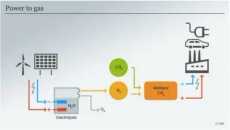Solid Oxide Fuel Cell (SOFC) for Combined Heat and Power (CHP) Applications Expected to Reach USD 38.04 Million by 2031
Introduction
The Solid Oxide Fuel Cell for CHP Applications Market is poised for remarkable growth over the next decade. With increasing emphasis on energy efficiency and sustainability, SOFC technology is gaining traction as a key solution for distributed power generation. According to recent industry analysis, the SOFC for CHP applications was valued at USD 10.97 million in 2023 and is projected to reach USD 38.04 million by 2031, growing at a compound annual growth rate (CAGR) of 16.8% over the forecast period of 2024-2031.
SOFC technology has emerged as a reliable and efficient alternative for CHP systems, offering high energy conversion efficiency and the ability to operate on a variety of fuels, including natural gas, biogas, and hydrogen. This press release delves into the dynamics, segmentation, and growth drivers shaping the future of SOFC technology for CHP applications.
Overview
Solid Oxide Fuel Cells are electrochemical devices that convert chemical energy from fuel into electricity through a highly efficient process. When integrated into Combined Heat and Power systems, SOFCs generate electricity while simultaneously producing heat, making them an ideal solution for both power generation and heating needs. SOFC technology is recognized for its high efficiency, low emissions, and fuel flexibility, which has propelled its adoption in various sectors, including residential, commercial, and industrial applications.
With increasing global focus on reducing greenhouse gas emissions and improving energy efficiency, SOFCs are gaining significant attention from governments, businesses, and energy providers. The demand for cleaner energy alternatives, combined with the rising awareness of climate change, has positioned SOFCs as a key contributor to the global energy transition.
Segmentation
The SOFC for CHP applications is segmented based on application (residential, commercial, industrial) and region.
By Application:
- Residential: In the residential sector, SOFCs are being increasingly utilized for small-scale CHP applications, providing efficient and reliable energy solutions for homes. The ability of SOFCs to operate on natural gas, which is widely available in many regions, makes them an attractive option for homeowners seeking to reduce their carbon footprint and energy bills. The residential segment is expected to witness steady growth as consumer interest in energy-efficient home systems continues to rise.
- Commercial: The commercial sector is one of the primary drivers of SOFC adoption, particularly in areas such as retail, hospitality, healthcare, and office buildings. SOFC-based CHP systems provide businesses with a reliable, decentralized power source while simultaneously generating heat for space heating or hot water. Commercial enterprises are increasingly turning to SOFC technology to enhance energy efficiency, reduce operating costs, and comply with stringent environmental regulations. This segment is projected to grow substantially over the forecast period.
- Industrial: The industrial sector represents a significant opportunity for SOFC-based CHP systems, particularly in energy-intensive industries such as manufacturing, chemical processing, and food and beverage production. SOFCs offer industries a reliable and scalable solution for generating power and heat on-site, reducing dependence on the grid, and lowering energy costs. Additionally, the industrial sector is under increasing pressure to decarbonize operations, further driving the adoption of SOFC technology.
Key Growth Drivers
Several factors are contributing to the rapid growth of the SOFC for CHP applications:
- Energy Efficiency and Sustainability: SOFC technology offers high energy conversion efficiency, with the potential to achieve efficiencies of up to 85% when used in CHP systems. This efficiency translates into lower fuel consumption and reduced carbon emissions, making SOFCs a highly attractive option for meeting energy demands sustainably.
- Rising Demand for Decentralized Power Generation: The growing need for reliable, on-site power generation, especially in regions with unstable grid infrastructure, is fueling the adoption of SOFCs. CHP systems powered by SOFCs provide a decentralized solution that ensures a continuous supply of power and heat, reducing the risk of energy disruptions.
- Government Support and Incentives: Governments around the world are implementing policies and offering incentives to promote the adoption of clean energy technologies. These initiatives are aimed at reducing carbon emissions, increasing energy efficiency, and fostering the development of renewable energy sources. For instance, several countries have introduced tax credits, grants, and subsidies for the installation of SOFC-based CHP systems, further driving growth.
- Technological Advancements: Ongoing research and development efforts are leading to significant advancements in SOFC technology, resulting in improved performance, lower costs, and enhanced durability. Innovations in fuel cell design, materials, and manufacturing processes are helping to overcome some of the challenges traditionally associated with SOFCs, such as high operating temperatures and material degradation.
- Fuel Flexibility: SOFCs can operate on a variety of fuels, including natural gas, hydrogen, and biogas. This fuel flexibility makes them highly adaptable to different regional energy infrastructures and enables their use in a wide range of applications. As the global transition to hydrogen-based energy systems accelerates, SOFCs are expected to play a critical role in the hydrogen economy, further boosting demand.
Regional Analysis
The SOFC for CHP applications is segmented by region, with key regions including North America, Europe, Asia-Pacific, and the rest of the world.
- North America: The North American is expected to see significant growth over the forecast period, driven by the increasing adoption of SOFC technology in the residential, commercial, and industrial sectors. The United States, in particular, has witnessed substantial investment in fuel cell technology, supported by government initiatives aimed at reducing carbon emissions and promoting clean energy. The region's well-established natural gas infrastructure also positions it as a key for SOFC adoption.
- Europe: Europe is a leading region for SOFC development, with strong government support for renewable energy and decarbonization efforts. The European Union's commitment to achieving carbon neutrality by 2050, along with stringent regulations on emissions, is expected to drive the adoption of SOFCs across various sectors. Germany, the UK, and the Netherlands are key players in the European , with significant investments in fuel cell technology and hydrogen infrastructure.
- Asia-Pacific: The Asia-Pacific region is experiencing rapid growth in the SOFC , particularly in countries such as Japan and South Korea, where there is strong government backing for fuel cell technology. Japan, in particular, has been a pioneer in residential fuel cell deployment, with its "Ene-Farm" program promoting the adoption of CHP systems in homes. The region's increasing focus on energy efficiency and sustainability is expected to further drive growth.
- Rest of the World: In regions such as Latin America, the Middle East, and Africa, the SOFC is still in its early stages, but there is significant potential for growth. These regions are increasingly exploring clean energy solutions to meet growing energy demands and reduce reliance on fossil fuels.
Conclusion
The global Solid Oxide Fuel Cell for CHP applications is set to experience significant growth, driven by rising demand for energy-efficient solutions, government support, and advancements in fuel cell technology. With a projected value of USD 38.04 million by 2031 and a robust CAGR of 16.8%, SOFC technology is well-positioned to play a pivotal role in the transition to a more sustainable energy future.
Read More Details @ https://www.snsinsider.com/reports/solid-oxide-fuel-cell-for-chp-application-market-3206
Contact Us:
Akash Anand – Head of Business Development & Strategy
Phone: +1-415-230-0044 (US) | +91-7798602273 (IND)
SNS Insider Offering/ Consulting Services:
Go To Market Assessment Service




